The original "Groźny" was built in January 1919 in Warsaw railway workshops, as the armoured train nr. 15 (P.P. 15 - Pociąg Pancerny nr 15). Initially, it consisted of improvised partially protected wooden freight wagons (two wagons protected with concrete in Nowy Sącz workshops, and a number of wagons protected with sand sandwich walls[11]). There is no detailed information on its composition. It participated in early part of the Polish-Soviet war in 1919, operating east of Kovel W. Because of a destroyed bridge on the Stochid before Kivertsi W, it did not go farther east and was used for patrolling of a captured area. Since the front moved east, and the train was of a little combat value, it was disbanded in September 1919 (its number 15 was next given to the "Paderewski"). Its name was however inherited by its stronger offspring, initially known as the "Groźny-szeroki".
The "Groźny-szeroki" was created as an improvised train in June 1919, of a stock captured in Kivertsi. It was a broad gauge (1524 mm) train, manned by a part of the original "Groźny's" crew; hence the train's name, in accordance with the Polish convention of that time, 'szeroki' meaning: 'wide' (gauge). Such trains were formed of a captured Soviet stock and could support advancing Polish units, operating on these parts of the captured area, where the railways have not been altered from the Russian 1524 mm gauge to standard 1435 mm gauge yet. Initially the train probably consisted of two open wagons with field guns, and some MG wagons. In August 1919 it was enlisted as a regular armoured train "Groźny-szeroki", with a number 22. It was however commonly known just as "Groźny" (what leads to confusion in most sources, not distinguishing between this train and the original "Groźny").
The final compostion of the "Groźny" was of two modern Soviet twin-turret artillery wagons of the same type. The first such twin-turret wagon, armed with two 76.2 mm guns, was assigned in March 1920. It was captured from a Soviet train BP no. 56 "Kommunar" near Olevsk W, on 17 March 1920 note 1. In March-October 1920, the "Groźny" consisted of one twin-turret wagon and a Soviet single-turret improvised wagon, constructed in railway workshops in Zdolbunov from a steel open four-axle coal wagon, with reinforced walls, a 76.2 mm artillery turret fitted in forward end and a protected casemate above the rest of the wagon. Its origin is not entirely clear; according to newest source it came from BP no. 104 "Imeni Karla Liebknechta", captured on 12 August 1919 note 2. Both wagons were also fitted with machine guns, and the train also had some other improvised MG wagon(s). Initially the train presumably had a Soviet broad-gauge series O locomotive (no details are known). From September 1920 it used a standard-gauge series 73 locomotive, fitted with a full armour in Poland.
The other twin-turret wagon was apparently assigned to the "Groźny" only after the end of hostilities in October 1920, but its origin is not clear. According to some sources, it came from a different unspecified train captured in autumn 1920, but it seems plausible, that it was the second wagon captured from BP 56 "Kommunar", first assigned to the train PP.19 "Podhalanin-szeroki" note 3.
After the war, "Groźny" remained in service, among 12 most modern trains. Probably only at that time it received its final composition of two twin-turret wagons. Since 1921 it was given a number (P.P.) 4.
In the winter of 1923/24 most of armoured trains were demobilised and stored in reserve, among them was also "Groźny". It should be noted, that organisational changes of the Polish armoured trains in inter-war period are not researched well so far and are not quite clear. "Groźny" was brought back to service probably in 1925 (or a bit later), because with "Śmiały" they were the first two trains assigned to the 2nd Armoured Train Unit (2. Dywizjon Pociągów Pancernych - 2. dpp) in Niepołomice near Cracow, newly created in 1928. During next years they were used for training there.
A final composition of the Polish armoured trains was probably established in 1929[7]. In early 1930s the train and its wagons underwent some modernization. The locomotive was changed to the standard type Ti3. The armament was standardised (100 mm wz.14/19A howitzer, 75 mm wz.02/26 guns and wz.08 machine guns) and anti aircraft machine guns were added. The train also received radio and signal equipment then. Probably in 1934, after modernization, "Groźny's" stock was brought back to a "mob" (mobilization) reserve (a significant fact, that its wagons on photos taken in late 1930s, still wear old camouflage).
In August 1939, during the mobilization, the 2nd
Armoured Train Unit mobilized five trains, among them the armoured train Nr. 54 of former "Groźny's" rolling stock (the names were not used any more officially). Its first commander was Cpt. Jan Rybczyński (killed on 02.09.39).
(According to some sources, Cpt. Rybczyński's body wasn't found, and the train was commanded by Reserve Lt. Ludwik Lipko during the rest of combat on that day[9]. Source [2] reports name of the train's technical platoon's commander as Reserve Lt. Józef Lipka.)
On 3 September the train nr. 54 was used once again in one short action towards Tychy and Wyry, shooting at the approaching units. All in all, actions of Nr.54 train in Upper Silesia in the first three days of the war were efficient and highly estimated, both by the Poles, and in German war diaries (...Slowly this monster rolls in our direction, from right to left... Stops, shoots for a minute, then goes farther... Once again this hell commences, when it returns... - one soldier wrote[10]). Later that day the train was withdrawn to Szczakowa to cover Polish positions on the Przemsza river. The whole front was collapsing, and on 4 September the train was protecting the right flank of the withdrawing GO "Jagmin" (former GO "Śląsk"). In the evening the train got under artillery fire. The tender was hit and the commander Cpt. Kulesza was slightly injured. According to some sources, the train had a skirmish with the German motorized unit near Tunel W station and later, in a fog, collided with and destroyed its own TK draisine, that had stopped on a track[9]. On 5 September the train's tankettes, sent to a reconnaissance, drove out German motorised pioneer patrol of the 27 Inf.Div., which was trying to destroy the track near Wolbrom W. In the evening the train went to Cracow, where it joined its auxiliary section (which went to Cracow through the other line on 4 September).
On 7 September the train was moving east towards Tarnów W, when there appeared, that the bridge upon the Dunajec before Tarnów is blown up. When the German patrols started to appear nearby (of the 2nd Armoured Division), Cpt. Kulesza ordered to leave the train, at Biadoliny station W. The Polish soldiers damaged the locomotive with explosives and took out the machine guns and guns' breeches. This decision, although justified, but may be considered too hasty, since the train could still delay the German advance on western bank of the Dunajec on that day. Part of the crew joined later the train nr. 51 at Rozwadów, while the other part joined Gen. Kleeberg's Independent Operational Group "Polesie" W.
 | An abandoned train nr.54 at Biadoliny station (from right: wagon with cannons, locomotive, assault wagon, wagon with a howitzer). |

German service:
This was the end of the "Groźny's", but not the end of its armoured rolling stock's service. The train was captured by the Germans and its history merges here with two newly formed German armoured trains: Panzerzug 21 and Panzerzug 22.
 |
Captured Polish armoured trains in Cracow, winter 1939/40 - in the foreground there are both artillery wagons and an assault wagon of "Groźny" (a 100 mm howitzer is visible). The locomotive is Ti3-13, from the train Nr.52 "Piłsudczyk" (other photo of that scene shows Ursus type observation turret). In a background, there is an artillery wagon and an assault wagon from the train Nr.52 "Piłsudczyk". A hatch in a turret's barbette is visible above German soldiers. |
The Panzerzug 21 was commissioned into service on 10 June 1940 and it all consisted of ex-Polish rolling stock. One artillery wagon (armed with 100mm howitzer and 75mm gun) and an assault wagon came from "Groźny" (the second artillery wagon came from the train nr. 52 "Piłsudczyk"). The train was used on the Eastern Front, and was captured by the Soviets in Mažeikiai W (Lithuania) on 30 October 1944.
- See the Panzerzug 21 gallery
The second artillery wagon from "Groźny", with two 75mm guns, was used in the German armoured train Panzerzug 22, commissioned on 10 July 1940. For most of the time, it used the locomotive Ti3-4, also from "Groźny". From 1941 till 1944 the train was used in an occupation service in France, then it was used on the Eastern Front. It was destroyed on 11 February 1945 in Sprottau.
- See the Panzerzug 22 gallery

Train's description (in 1939):
The armoured train nr. 54 consisted of:
An armoured train, as a military unit, consisted of: an armoured section, a platoon of armoured draisines and an unarmoured auxiliary section. The armoured section and armoured draisines were the combat section of the armoured train, while the auxiliary section was supporting the operation of the combat section in respect of logistics and accommodation, and did not take part in combat.
Locomotive:
A standard locomotive of the Polish armoured trains from 1927 was the armoured steam locomotive series Ti3 (former Prussian series G53), fitted with full armour in Poland. The locomotive of "Groźny" was Ti3-4 (former G53-4023 Koenigsberg), manufactured in 1903 by Egestorff, factory number 4116. The locomotive had a command turret upon a tender and was fitted with a short-range radio RKB/C to contact the draisines (more on Ti3 page) (see a gallery of Ti3-4 with German modifications).
Artillery wagons:
 |
| One of the "Groźny's" artillery wagons (two 75mm guns and 9 MGs) in a jagged camouflage from the early 1930s. ↑[1] ˇ[5] |
 |
The "Groźny" in its final composition had two Soviet-built four-axle twin-turret armoured artillery wagons, constructed in 1919-early 1920.
Both were of the same type, differing in artillery turrets and details only. Turrets were seated upon low, rounded barbettes, on each wagon's end. A horizontal angle of fire was about 270° for each turret. Their type nor builder are not determined so far (they don't belong to any of common Soviet types; source [4] calls the type "modified Krasnoye Sormovo", what seems groundless). They might be a modified variant of wagons constructed in Izhorski Works in Izhorsk. Their significant feature, unseen on common Soviet wagons, was a single rounded access hatch on each side. In the Polish service, a gauge of captured wagons was changed from broad gauge 1524mm to standard 1435mm, and they were subsequently fitted with hinged armour skirts at the bottom, in addition to existing fixed skirts on bogies and under a middle part. In a gun-armed wagon there were also made small round hatches in bogies' skirts, for axis maintenance.
The first, cannon-armed wagon (no. 450 012) was captured in March 1920. In 1939, its main armament were two 75mm wz. 02/26 (modified 3in Putilov)
field guns in two turrets. The turrets were of the same type, as in "Krasnye Sormovo" type wagons (eg. in "I Marszałek" train), but they had different rounded style of barbettes. In the beginning of the service the wagon apparently had Russian 76.2mm wz.02 (M.1902) guns (3in Putilov).
|
Other armament consisted of nine 7.92mm wz. 08 (Maxim) heavy machine guns: four in forward ports in artillery turrets, on either side of guns, four in cylindrical mountings in wagon's sides, and an AAMG. Presumably the original machine guns were Russian 7.62mm Maxim M.05 or M.10.
This wagon was later used in the German Panzerzug 22. Apparently in the German service this wagon was fitted with small hatches in turrets' barbettes, in the wagon's longitudinal axis, enabling passing between wagons.
|
 |
|
A good view of a "Krasnoye Sormovo" type artillery turret of former "Groźny's" wagon in the Panzerzug 22 en face. Oval ports for machine guns are visible on both sides of the 75mm wz. 02/26 gun. Note, that upper side corners were cut off, to better fit Western European loading gauge. A searchlight might be a German modification. [3] |

|
| The other wagon - 75mm gun and 100mm howitzer (in right turret) [5] |
The second artillery wagon (no. 460 025) was armed with one 100mm wz. 14/19A (Skoda) howitzer and one 75mm wz. 02/26 field gun in two different turrets (the gun was in a cylindrical turret). Other armament consisted of four 7.92mm wz. 08 (Maxim) machine guns in the sides (plus an AAMG). This wagon was later used in the German Panzerzug 21. In 1921 it was probably briefly used in the armoured train "Piłsudczyk". This wagon was equipped from a beginning with small (evacuation only?) hatches in turrets' barbettes, offset to the left from the wagon's longitudinal axis in each barbette (they were later moved by the Germans to a longitudinal axis). This wagon was originally apparently fitted with 76.2mm wz.02 (M.1902) gun and some howitzer, probably Russian 122mm (4.5in) howitzer. It is not known, if the howitzer was an original weapon, or fitted in the Polish early service. It is also not clear, if the howitzer turret was original, or if it was fitted in a place of other cylindrical turret. In order to fit the wagon with the Polish 100 mm howitzer, a front part of this turret was lengthened a bit forward. The Germans later added small hatches in bogies' skirts for axis maintenance.
In early 1930s, each of artillery wagons was fitted with one 7.92mm wz. 08 anti-aircraft machine gun in a small central turret on the roof, with a maximum elevation of 90°. There is no specific information concerning the train Nr.54, but the ammunition carried in wagons must have been similar to the train Nr.53 - 3,750 rounds per each MG (in 250-round belts) and some 120 artillery rounds per artillery piece[7].
There is no specific information concerning the train's armour, but its thickness was about 8 - 12mm (it was also probably covered with oak planks from the inside, as in the Polish-built wagons). The crew of each artillery wagon was about 35 men.
 |  |
| View on the "Groźny's" 100 mm howitzer, after its capture by the Germans. |
 |  |
Left: the gun-armed wagon of the train Nr.54 after being captured [AJ]
Right: the howitzer-armed wagon in the Panzerzug 21, wearing a German camouflage. Apparently the Germans modified the wagon, moving a barbette hatch to a longitudinal axis, to enable passing between wagons. Note maintenance hatches on bogies' armour. |
Assault wagon:
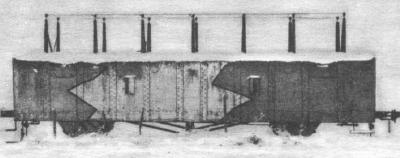 |
| The assault wagon of the "Groźny" in the 1930s. [1] |
 |
| The assault wagon of "Groźny" in the German Panzerzug 21. Polish cylindrical MG mountings are replaced with simple fire ports. Note significant rounded roof sides. [3] |
The assault wagon (Polish nomenclature) was intended for the transportation of an assault platoon. The wagon of the "Groźny", number 631 550, was built around 1920 in Poland, as an artillery wagon with a central cylindrical turret, used probably in the train "Paderewski". In the early 1930s it was rebuilt to an assault wagon, with turret removed (according to [8], it was built in the railway workshops in Nowy Sącz, as an artillery wagon of the train "Stefan Czarniecki", but this train had different artillery wagons on photos).
The assault wagon was armed with four 7.92mm wz. 08 (Maxim) machine guns in the sides. The ammunition was probably 3,750 per MG. The armour was similar in thickness to artillery wagons, constructed of 11 narrow vertical stripes. The assault platoon consisted of 32 men (1 officer, 7 NCO's, 24 soldiers, with rifles and 2 light machine guns). The total wagon's crew was about 40 (with signalmen and stretcher-bearers).
The assault wagon was equipped with a long-range radio RKD/P (range - up to 100km), placed in a separate radio cab in the middle of the wagon. The wagon was also fitted with a power generator, batteries and a large clothes line aerial on the roof (7 masts in two rows, each supported by struts towards inside).
Apart from side doors on each side (near wagon's end), the wagon had doors in end walls and also hatches in a floor.
The crew of the train's armoured section was about 120-130 men - the whole armoured train's crew (with an auxiliary section and draisines) was about 190.
The Polish camouflage on the pictures above and a title photo, with sharp black edges, was used until late 1930s only. The colors were probably: light grey, green and brown. By 1939, the train was painted in a standard three-color camouflage of the Polish vehicles, of brown green and dark brown irregular patches upon a greyish sand basic color.
Flatcars:
On both ends of the armoured train there were two two-axle flatcars. Their primary function was to protect the armoured train against mines or a derailment. They were also adapted to carry engineering materials (tools, rails and sleepers, logs, explosives etc.) and also bicycles and motorcycles (part of it was carried on the auxiliary train's flatcars).
The standard flatcar was series Pdkz, type VIIIC[7]. Weight - about 10 t, load capacity - 17.5 t, length - 13 m (511 in), wheelbase - 8 m (315 in). Other types of two-axle flatcars were also used.
Armoured draisines platoon:
 |
| It is likely, that this photo presents an abandoned draisine platoon and a part of an auxiliary section of the train Nr.54, with wz.34 halftrack car, three draisines TK, two draisines R and two empty runners for TK draisines. |
Each armoured train in 1939 had a platoon of armoured draisines (scout rail vehicles). The train nr.54 had a standard armoured draisines platoon, consisting of:
- two R type armoured draisines (FT-17 tanks on a rail chassis)
- four TK type armoured draisines (TK or TKS tankettes on a rail chassis)
Draisines usually acted in two units, consisting of one R and two TK draisines each. All tanks could be easily detached from their rail chassis' and then used for ground reconnaissance tasks. The fifth TK tankette should be in reserve, carried on an auxiliary train's flatcar. Read more on armoured draisines page.
Auxiliary train:
Each armoured train, considered as a military unit, also included an unarmoured auxiliary section. The auxiliary section accompanied the combat section in operational movements and provided it with an accommodation and logistics support. It was manned by a platoon consisting of 1 officer, 21 NCO's and 26 soldiers. The length of the auxiliary section of the train was about 250 m (820 ft).
The auxiliary train consisted of: a locomotive, coaches for officers (2), wagons for NCOs (2) and soldiers (8), bureau wagon, ammunition wagons (2), a fuel store wagon, a technical store wagon, an armoury wagon, an ambulance coach, a kitchen coach, a workshop wagon, a coal wagon, a water tanker and flatcars (5) - some 23 carriages (source [2]). The coaches were three-axle Dy type, the wagons were by default two-axle freight wagons Kd type, the flatcars were two- or four-axle.
The auxiliary train also had two wz.34 half-tracked trucks, one truck (Polski FIAT 621?) and four motorcycles with sidecars CWS M-111 - carried upon three flatcars. Wz.34 half-tracks were in the repair patrol, and they could be equipped with a rail-riding device.

All corrections and additional informations or pictures are welcome!
Our thanks for help with pictures to Jarkko Vihavainen, Jerzy S. Prajzner and Artur Przeczek
- and for early historical part to Krzysztof Margasiński.
Notes:
-
It is commonly acknowledged, that the first twin-turret wagon of "Groźny" came from the Soviet train BP 56 "Kommunar" ('Communard'), captured on 17 March 1920[8,12]. P. Malmassari[4] quotes the name "Kommunist", which is probably misread "Kommunar". Also according to the "Groźny's" crewman's relation, in spring of 1920 the train's crew mined the track and blew up the Soviet train "Komunar", capturing two armoured wagons with 4 guns and 15 MGs[6]. Unfortunately, history of Soviet trains hasn't been researched well so far. According to Russian sources, the train "Kommunar" (numbered as BP 4, then BP 56) survived all the Russian Civil War and fought with the Poles in October 1920 at Korosten, in which it distinguished itself and was honoured with a Revolutionary Red Banner, as one of only two trains. The train however might have been created again after a loss of its stock.
On the other hand, in its 1919 composition, the BP 4 "Kommunar" consisted of a light part and heavy part, and neither included such twin-turret wagons. The Soviet sources show also drawings of the train named "Kommunist" from Korosten area, with other type twin-turret wagons.
- There are also unclear issues about the Soviet train, from which the single-turret wagon was taken. According to P. Malmassari[4], apparently basing upon Polish informations, it was "Karl Liebknecht". There is also another information, that this wagon came from train BP no. 60, which was a number of "Imeni Karla Liebknechta" ('Karl Liebknecht's [train]'). Again, according to Soviet sources, BP 60 "Imeni Karla Liebknechta" had only two twin-turret wagons (of a different type, than "Groźny"), but it could have been created again with new stock. However, according to newest source [12], this wagon came from BP no. 104 "Imeni Karla Liebknechta", captured on 12 August 1919 at Rivne.
- According to [8], the other "Groźny's" twin-turret wagon came from other train, captured in autumn of 1920. However, it is known, that two armoured wagons with 4 guns were captured on 17 March 1920 from the "Komunar". It is not known, what was the second wagon. According to [12], it was assigned to armoured train PP.19 "Podhalanin-szeroki", disbanded after the war. Therefore it seems logical, that the second "Groźny's" twin-turret wagon might have originated from the "Kommunar" as well, because both wagons are of the same type, quite uncommon in addition. The Soviets usually equipped newer trains with two twin-turret wagons of the same type.
- German units according to Rajmund Szubański, "Polska broń pancerna 1939", Warsaw 2004. In 1989 edition, there were different numbers (respectively: 8 ID instead of 3 ID, 28 ID instead of 23 ID, III/48 Btn instead of III/43 Btn). On the other hand, Szubański in "Pancerne boje września" quotes diaries of soldiers from I/49 and II/49 Btns of 28 ID, also fighting against the armoured train on that day. Write, if you have information on correct German units taking part in this combat.
Sources:
1. Janusz Magnuski, "Pociąg pancerny 'Danuta'", Typy Broni i Uzbrojenia (TBiU) No.18; Warsaw 1972
2. Rajmund Szubański, "Polska broń pancerna w 1939 roku"; Warsaw 2004 (also 1989 edition)
3. Wolfgang Sawodny, "Die
Panzerzüge des Deutschen Reiches"; EK Verlag, Freiburg 1996
4. Paul Malmassari, "Les Trains Blindes 1826 - 1989"; Editions Heimdal, 1989
5. Tadeusz Jurga, "Regularne jednostki Wojska Polskiego w 1939 r. Organizacja, działania bojowe..."; Warsaw 1975
6. collective work, "Pociagi pancerne 1918-1943", Białystok 1999
7. Janusz Magnuski, "Pociąg pancerny 'Śmiały' w trzech wojnach"; Pelta; Warsaw 1996
8. Janusz Magnuski, "50 lat września - Broń pancerna" in: "Wojskowy Przeglad Techniczny", nr. 9/1989
9. Adam Jacek Ostrówka, "Pociągi pancerne Wojska Polskiego 1918-1939", Toruń 2004, ISBN 978-83-7611-232-9
10. Rajmund Szubański, "Pancerne boje września"; ZP Grupa, Warsaw 2009, ISBN 978-83-61529-29-3, s.78-81
11. Tadeusz Krawczak, Janusz Odziemkowski, "Polskie pociągi pancerne 1918-1939", in: WPH 4/1979, p.125
12. Józef Jurczyk, Krzysztof Margasiński, "Dziennik pociągu pancernego Hallerczyk", Czechowice-Dziedzice - Częstochowa 2010
AJ - collection of Adam Jońca
Update history:
05.11.2011 - added some photos, improvements to text (detailed notes about wagons' origin removed from main text)
xx.01.2010 - minor text additions (BP 56 doubts; wagon numbers)
22.12.2009 - minor improvements
14.12.2009 - major update - corrected early history and others, added photos
08.12.2009 - major update - text revised, improved and added photos
16.07.2004 - added a photo, text revised
05.05.2003 - corrected and improved, especially History.
28.02.2002 - revised, added a photo, improved
16.02.2001 - added a photo, history improved
16.09.2000 - added some German photos and improved the text (composition mainly).
[ Main page ] [ Polish armour / Polish armoured trains ]
[ Polish armoured units ] [ Steel Panthers page ]
You can mail
me with any questions or comments. Corrections and photos are welcome!
All photos and pictures remain the property of their owners, unless they are public domain. They are published in non-commercial educational and research purpose.
Text copyright to Michal Derela © 2000-2011.




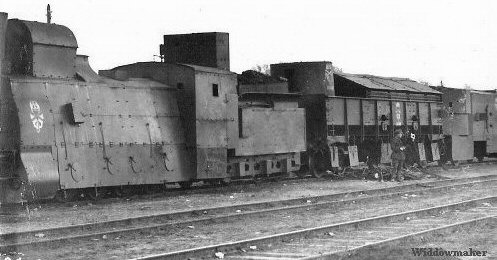
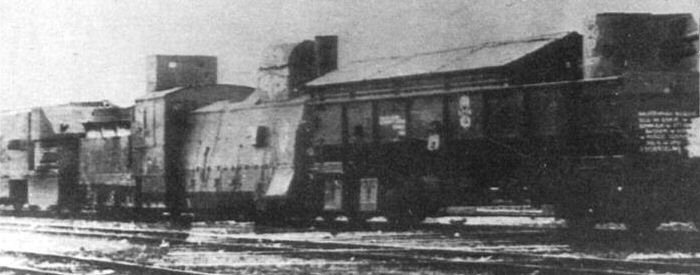
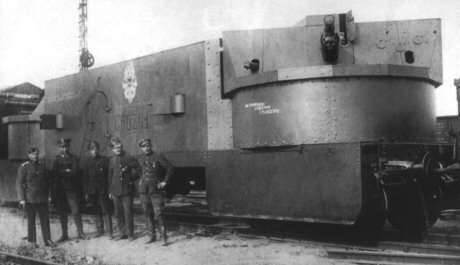
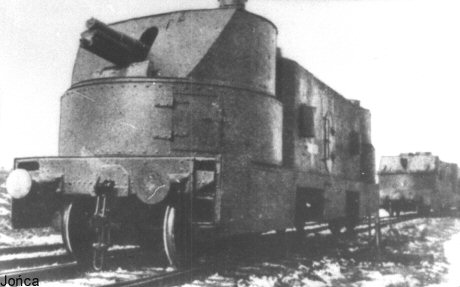
 In August 1939 the armoured train Nr. 54 was assigned to the GO "Śląsk" (Operational Group "Silesia") of the Cracow Army (
In August 1939 the armoured train Nr. 54 was assigned to the GO "Śląsk" (Operational Group "Silesia") of the Cracow Army (















